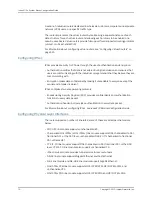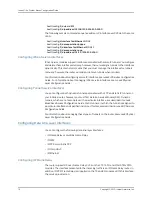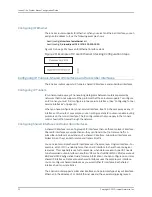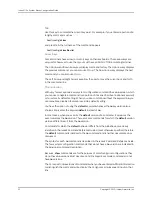
•
Data mapping—The process of getting data packets onto an established LSP.
See
JunosE BGP and MPLS Configuration Guide ,
for information about configuring
MPLS.
In addition, if you want to make configuration adjustments to IP, see
JunosE IP, IPv6, and
IGP Configuration Guide
, for details.
Configuring VRRP
The Virtual Router Redundancy Protocol (VRRP) can prevent loss of network connectivity
to end hosts if the static default IP gateway fails. By implementing VRRP, you can
designate a number of routers as “ backup” routers in case the default “ master” router
fails. You can configure VRRP on IP/Ethernet interfaces.
For information about configuring VRRP, see
JunosE Services Availability Configuration
Guide
.
Configuring Routing Policy
The router supports a number of features that allow the service provider to control the
exchange of routing information between virtual routers in the router, between routers
in the network, and between protocols within a router:
•
Access lists—Provide filters that can be applied to route maps or distribution lists. They
allow policies to be created, such as a policy to prevent forwarding of specified routes
between the BGP-4 and IS-IS routing tables.
•
Route maps—Modify the characteristics of a route (generally to set its metric or to
specify additional attributes) as it is transmitted or accepted by a router. Route maps
can use access lists to identify the set of routes to modify.
•
Distribution lists—Control the routing information that is accepted or transmitted to
peer routers. Distribution lists always use access lists to identify routes for distribution.
For example, distribution lists could use access lists to specify routes to advertise.
•
Redistribute routes—Allow routes to be shared between routing protocols and routing
domains. For example, a subset of BGP-4 routes could be leaked into the IS-IS routing
tables.
See
JunosE IP Services Configuration Guide,
for details
.
Configuring QoS
QoS is a suite of features that configure queuing and scheduling on the forwarding path
of your E Series router. QoS provides a level of predictability and control beyond the
best-effort service that is the E Series router’s default data delivery service. Packets not
assigned to a specific traffic class are carried in the best-effort traffic class. Best-effort
service provides packet transmission with no guarantee of results.
The major QoS features that the E Series router provides are:
Copyright © 2010, Juniper Networks, Inc.
24
JunosE 11.3.x System Basics Configuration Guide
Summary of Contents for JUNOSE 11.3
Page 6: ...Copyright 2010 Juniper Networks Inc vi...
Page 8: ...Copyright 2010 Juniper Networks Inc viii JunosE 11 3 x System Basics Configuration Guide...
Page 24: ...Copyright 2010 Juniper Networks Inc xxiv JunosE 11 3 x System Basics Configuration Guide...
Page 32: ...Copyright 2010 Juniper Networks Inc 2 JunosE 11 3 x System Basics Configuration Guide...
Page 146: ...Copyright 2010 Juniper Networks Inc 116 JunosE 11 3 x System Basics Configuration Guide...
Page 166: ...Copyright 2010 Juniper Networks Inc 136 JunosE 11 3 x System Basics Configuration Guide...
Page 432: ...Copyright 2010 Juniper Networks Inc 402 JunosE 11 3 x System Basics Configuration Guide...
Page 488: ...Copyright 2010 Juniper Networks Inc 458 JunosE 11 3 x System Basics Configuration Guide...
Page 524: ...Copyright 2010 Juniper Networks Inc 494 JunosE 11 3 x System Basics Configuration Guide...
Page 554: ...Copyright 2010 Juniper Networks Inc 524 JunosE 11 3 x System Basics Configuration Guide...
Page 566: ...Copyright 2010 Juniper Networks Inc 536 JunosE 11 3 x System Basics Configuration Guide...
Page 588: ...Copyright 2010 Juniper Networks Inc 558 JunosE 11 3 x System Basics Configuration Guide...
Page 613: ...PART 3 Index Index on page 585 583 Copyright 2010 Juniper Networks Inc...
Page 614: ...Copyright 2010 Juniper Networks Inc 584 JunosE 11 3 x System Basics Configuration Guide...
Page 632: ...Copyright 2010 Juniper Networks Inc 602 JunosE 11 3 x System Basics Configuration Guide...
















































